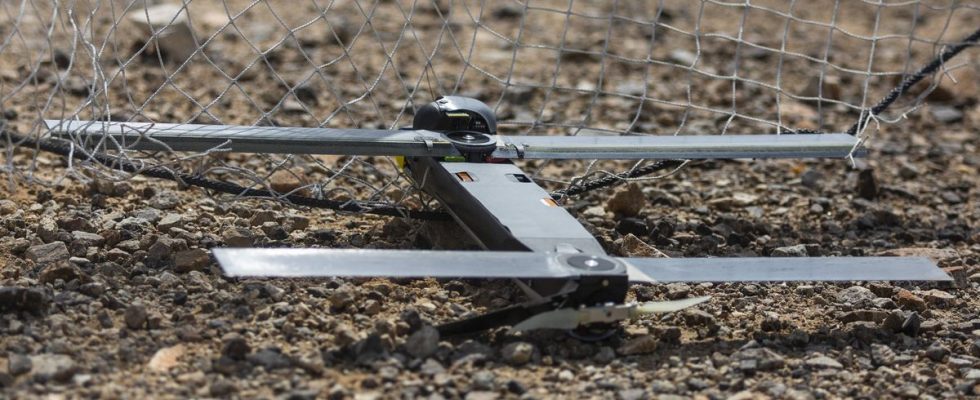War, revealing shortcomings and ground for innovation. Soldiers and experts agree that in wartime, everything is easier, simpler, faster. And that the urgency in which a nation at war finds itself encourages innovations, many of which will then be inspired by a “normal process of feedback”, recognizes Vincent Desportes, former soldier, professor of strategy Sciences po Paris. This is how the French armed forces closely observe what is happening in Ukraine, in particular the intensive use of drones of all types. The conclusion is clear, we are late.
We talked about it recently in 20 minutes, Ukrainian soldiers make frequent and unorthodox use of recreational drones in the field to carry out observation or attack missions. A diversion with a lot of “hack” which could seem anecdotal, except that in practice, the military interest is not insignificant: “The presence of many drones on the front lines has a significant psychological effect on the enemy who does not feel safe anywhere”, assures Lieutenant-Colonel Pierre-Yves of the Program and Weapons Systems Office of the General Staff of the French Army. “It is also effective in the sense that the mere presence of these devices is constraining, forcing the Russians to take this threat into account by deploying jamming capabilities,” he adds. Learning to be wary of drones is a point which is now becoming widespread in the training of French soldiers.
“The Transparency of the Battlefield”
However, it was not the Ukrainian conflict that made the French military discover this threat. The most edifying case dates back to 2008, during an operation by French soldiers engaged in the international assistance and security force (ISAF) in Afghanistan. “There was this Taliban ambush in the Uzbin valley during which 21 French soldiers were killed,” recalls Michel Goya, former colonel in the navy troops, historian and strategist. “At the time, everyone wondered why we hadn’t used drones to go and look at what was on the pole in which we were ambushed,” he recalls.
“This is one of the positive effects that we observe from the use of civilian drones in Ukraine: the transparency of the battlefield”, recognizes Lt-Colonel Pierre-Yves. This is how the French army acquired many civilian drones for training purposes: “All our units must learn to use drones in the implementation of the tactics to be adopted, he continues. For example, the captain, before investing a village, he sends his drone to observe the entrances to the village, locate the enemy and that allows him to set up his maneuver”.
“Kamikaze drones” purchased urgently
In addition to the interest of civilian drones, Ukrainian soldiers also very quickly experienced the effectiveness of so-called “kamikaze” drones. Here again, it started with hacks, when the Ukrainians fixed explosive charges on drones using makeshift systems and then launched them at armored vehicles, in trenches or at planes in the parking lot. We saw the demonstration of this recently, when a Ukrainian unit was able to render a Russian reconnaissance aircraft inoperative by detonating a small FPV drone above its radar. Volodymyr Zelensky’s army has nevertheless moved upmarket with the acquisition of several hundreds of Switchblade 300from the American manufacturer AeroVironment.
The advantages of these “remotely operated ammunition” compared to a missile are multiple: being able to choose your target once in the air, aborting an attack if necessary, their extreme portability… “We don’t have that because in didn’t see the point of it. But it is a real shortcoming that we will try to repair quickly after having noted their effectiveness in Ukraine”, concedes the staff officer. So much so that an emergency purchase of 72 Switchbalde 300s was launched to train French special forces in this type of weapon.
A gap to be filled by 2030
According to historian and strategist Michel Goya, the war therefore made the Ukrainian army go from novice to pioneer in the use of drones. Which is still far from being the case in France. “This war has allowed us to become even more aware of the backwardness that we have here. Drones are a symptom of the problems we encounter with military manufacturers who are pushing towards the expensive high end instead of going towards the low cost”, he believes.
The other concern is the weight of administration and procedures. When the special forces more easily obtain exemptions to equip themselves and experiment, the mass acquisitions of new equipment go through much more cumbersome procedures: “For drones, you have to define the needs, define the budgets, launch calls for offers. Yes, it can take a few years,” confirms Lt-Colonel Pierre-Yves. It is in this direction that the new military programming law “France will engage more frankly in areas such as cyber, space, intelligence, next-generation ground-to-air defense and drones,” confirmed Sébastien Lecornu, Minister of the Armed Forces, last January. For the period 2024-2030, “these themes alone represent several tens of billions of euros”, he added.

